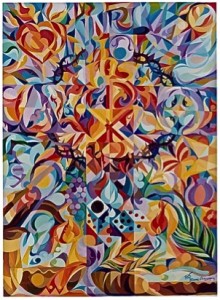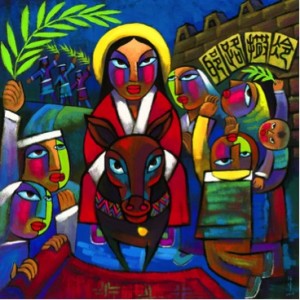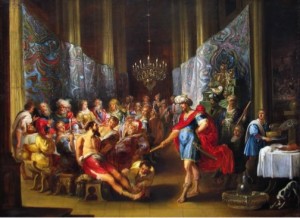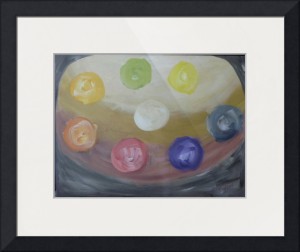As part of our 40-day journey during the 2015 season of Lent, Deb Murphy (Director of Spiritual Formation of Children & Youth and FCC Office Manager) led us in the spiritual discipline of seeing Lent through art. Each week Deb will share a different piece of artwork and the meaning behind it, culminating in the celebration of Resurrection Sunday on Easter.
Easter Sunday – April 5, 2015
Glory of the Cross by Sawai Chinnawong
Sawai Chinnawong is a Christian artist in Thailand, known for depicting scenes from scripture influenced by the traditional art of Central Thailand. Several of his works are similar to this one – made up of many different shapes and figures in vibrant colors (another favorite of mine is Genesis 7:13). I see something new in this image every time I look at it. What jumps out at you? What things do you see? Share this image with someone and find out what they see. Consider why all of these things are part of the glory of the cross. And what does that mean to you, the glory of the cross? Come back to the picture in a few days or a week or two. Do you spot something new? Is something now prominent that wasn’t before?
Chinnawong does not have prints made of his works and he lives in Thailand, so I was having difficulty in tracking down rights and permissions to use his work. There wasn’t even a poster available for purchase. I was corresponding with a missionary friend, Anne Gregory, in Thailand, complaining (whining really) about the difficulty I was having. As it turns out, Anne’s housemate, Sharon Bryant, is a very good friend of Chinnawong’s. When Anne explained my problem, the housemate got on the phone and got permission for me to use his work for our Lenten Art Journey. And the fee, because there is always a fee, is a thank you note!
Palm Sunday – March 29, 2015
Triumphant Journey Into Jerusalem by He Qi
About The Art:
He Qi (pronounced huh chee) is a Chinese Christian artist. Born in China, he now lives in Roseville, MN. He paints in a traditional Chinese folk style, using biblical themes from both Testaments. He Qi is one of my favorite artists – his style, use of color, and interpretation of scripture. I looked at a lot of different art to find something for Palm Sunday and there are a lot of choices out there. One of the reasons I picked this one is that Jesus is looking straight ahead – straight at the viewer – straight at me. Most of the images I found show Jesus from the side, surrounded by a very large crowd. He Qi’s painting has only a few people, but they are “up close and personal,” so to speak. Take a look at the people surrounding Jesus. What are they doing…or not doing? Who is waving a palm or placing a rug on Jesus’ path? Who isn’t? What might they be thinking?
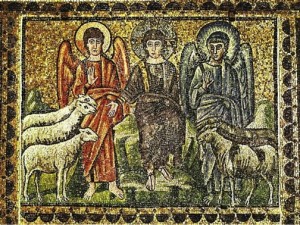 5th Sunday in Lent – March 22, 2015
5th Sunday in Lent – March 22, 2015
Christ separating the sheep and goats, Ca. 6th century, mosaic, Basilica of Sant’ Apollinare Nuovo, Ravenna, Italy.
About The Art:
This image is from the Basilica of Sant’Apollinare Nuovo at Ravenna, a city near the Adriatic Sea in the northeast end of the Italian boot. Ravenna was the capital city of the Western Roman Empire from 402 until that empire collapsed in 476. It then served as the capital of the Kingdom of the Ostrogoths until it was re-conquered in 540 by the Byzantine Empire. Sant’Apollinare Nuovo was originally built by the Ostrogoth ruler Theodoric as his palace chapel in the early 6th c., was later reconsecrated by the Byzantine emperor Justinian in 561, and was given its present name in 856. Like all Byzantine mosaics, the gold background indicates sacred space. [Note – This is also an element in Nelly Bube’s painting of the “Workers in the Vineyard” from the second Sunday in Lent.] Jesus is clothed in royal purple and seated on a throne. Flanked by two angels, Jesus extends his right hand toward the three sheep at his right as he stares out at the viewer, while ignoring the three goats at his left. The sheep on the right will inherit the kingdom.
 4th Sunday in Lent – March 15, 2015
4th Sunday in Lent – March 15, 2015
Jesus Mafa Painting: The Ten Young Women courtesy of Vanderbilt Digital Library
About The Art:
The Mafa Christian Community of North Cameroon wanted an African representation of the Gospel. In 1973, a committee formed to create that project. They selected what they consider to be the most important New Testament scenes for liturgical and catechetical use and then adapted them to be played by the people in the village. These scenes were photographed and drawn. After a careful and detailed study, the Jesus Mafa paintings were executed by the French artist, Bénédite de la Roncière.
In Jesus Mafa paintings, the characters and the environment belong to Africa in much the same way that medieval religious paintings belong to the characters and environment of that day and age. In total, there are 62 scenes from Annunciation to Pentecost.
Points to Ponder: Read the parable (Mt 25:1-13). What parts of the parable do you see in the painting? Which women don’t have oil? What do they seem to be trying to do about it, if anything? What about the wedding party?
3rd Sunday in Lent – March 8, 2015
Guest Without Wedding Attire by Vincent Adriaenssen (17th Century)
About The Art:
This painting is by Flemish Baroque artist Vincent Adriaenssen, who was born in Antwerp in 1595 and died in Rome in 1675. Considered to be an Old Master of the Italian School, Adriaenssen’s work often gets confused with Vincent Malo’s work, who painted at about the same time. Adriaenssen spent time in Paris 1662-1645 and again in 1648, doing work for Cardinal Mazarin and Cardinal Richelieu (of Three Musketeers fame).
Most of Adriaenssens works were frescos, landscape paintings, and religious paintings. The title is Guest Without Wedding Attire. This detail takes center place in the painting and is how we know it is based on Matthew and not the wedding feast story in Luke. Read the parable and then spend some time examining this work. Is there anything in particular that leaps out at you? What sort of crowd is at the feast? Does the clothing say anything to you? Did you notice the servants and the dog? Did you spot the pregnant lady? What might all of this say about Adriaenssen’s interpretation of the parable?
2nd Sunday in Lent – March 1, 2015
Workers in the Vineyard by Nelly Bube, courtesy of Vanderbilt Digital Library
About The Art:
This painting is by contemporary German-Russian artist Nelly Bube. She was born in 1949 in Astana, Kazahkstan and currently lives in Almaty, Kazahkstan.
Points to ponder: I find this painting (and many of her others) reminiscent of both Russian icons and early medieval paintings in appearance. She also shows two different points in time in the same work. The top portion shows the owner hiring men to work in the fields. The bottom portion shows the men being paid. Talk a close look – what does their posture and body language tell you? Can you make anything out in their facial expressions? Did you notice that the men are being paid in reverse order of how they were hired? How well does this tell the story for you?
First Sunday in Lent – February 22, 2015
“Circle of Forgiveness” by Yvonne Tardif
About the Art:
Description from the artist: “first round is grey means a person feels guilty, and ask for forgiveness, it moves to the round purple, it get bit lighter of guilty, ask again for forgiveness, then goes to round red etc.”
About the Artist
As a young girl growing up in Holland, Yvonne ‘s passion for art started at a very young age. This passion was put on hold when Yvonne was enrolled into a school for the deaf. It wasn’t until she was nineteen that she could resume the hobby she loved, at which time she started taking various art courses in Holland. Since Yvonne’s move to Canada in 1983, she has continued to learn and grow as an artist. Visit her website: http://breeasea.shawwebspace.ca


